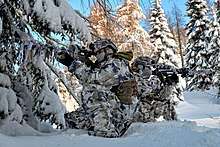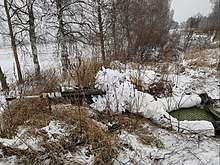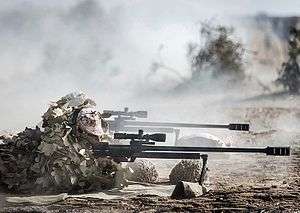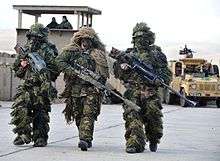Ghillie suit
A ghillie suit is a type of camouflage clothing designed to resemble the background environment such as foliage, snow or sand. Typically, it is a net or cloth garment covered in loose strips of burlap (hessian), cloth, or twine, sometimes made to look like leaves and twigs, and optionally augmented with scraps of foliage from the area.


Military personnel, police, hunters, and nature photographers may wear a ghillie suit to blend into their surroundings and conceal themselves from enemies or targets.[1] The suit gives the wearer's outline a three-dimensional breakup, rather than a linear one. When manufactured correctly, the suit will move in the wind in the same way as surrounding foliage. Some ghillie suits are made with light and breathable material that allows a person to wear a shirt underneath.

A well-made ghillie suit is extremely effective in camouflaging its wearer. A ghillie-suited soldier sitting perfectly still with local flora attached to their webbing is nearly impossible to detect visually, even at close range. However the suit does nothing to prevent thermal detection using technologies such as FLIR. In fact, the warmth of the heavy suit can make a wearer stand out more than a standard soldier when viewed using these methods.


History
Gille is a Scots Gaelic word for a young man or older boy who works as an outdoor servant. "Ghillie" is a mis-spelling. The term "ghillie suit" may be a reference to Gille Dubh the "Dark Lad" or "Black Lad", a Earth spirit who is clothed in leaves and moss in Scottish mythology.[1]
The Lovat Scouts, a Scottish Highland regiment formed by Simon Fraser, 14th Lord Lovat during the Second Boer War, is the first known military unit to use ghillie suits and in 1916 went on to become the British Army's first sniper unit.[2][3] The Lovat Scouts were initially recruited from Scottish Highland estate workers, especially professional stalkers and gamekeepers.[4]
Similar sniper outfits in the Australian Army are nicknamed "yowie suit", named for their resemblance to the Yowie, a mythical hominid similar to the Yeti and Bigfoot which is said to live in the Australian wilderness.[5]
Safety considerations
Although highly effective, ghillie suits are impractical for many situations where camouflage is useful. They tend to be very heavy and hot. Even in moderate climates, the temperature inside the ghillie suit can reach over 50 °C (120 °F). The burlap is also flammable, unless treated with fire retardant, so the wearer may be at increased risk from ignition sources such as smoke grenades or white phosphorus.
To enhance safety, the US Army Soldier Systems Center has developed an inherently fire-resistant, self extinguishing fabric to replace the jute or burlap. This material was field tested in late 2007 at the Sniper School at Fort Benning and has been standard issue since June 2008. Furthermore, the italian company ProApto in 2015 introduced new lighweight and waterproof-breathable design for Ghillie Suit, enableing the users with more reliable and functional camouflage systems.
Civilians have purchased ghillie suits to commit crimes. Police arrested an Australian man after they found that he had assaulted women while wearing such a suit.[6]
References
- David Amerland (2017), The Sniper Mind: Eliminate Fear, Deal with Uncertainty, and Make Better Decisions, St. Martin's Press, p. 53, ISBN 978-1-250-11368-9
- Pegler, Martin (2004). Out of Nowhere: A History of the Military Sniper. Osprey Publishing. ISBN 978-0-87364-704-5.
- Plaster, John (2006). The Ultimate Sniper: An Advanced Training Manual For Military And Police Snipers. Paladin Press. p. 5. ISBN 978-0-87364-704-5.
- Pegler (2004), S. 129
- Hogben, Bruce (17 June 1989). "Aussie ingenuity keeps our soldiers safely out of sight". The Advertiser. Adelaide, Australia.
- "Central Coast father to face court over schoolgirl's assault". Au.news.yahoo.com. 2017-08-27. Retrieved 2018-01-31.

Further reading
- Kevin Dockery: Stalkers and Shooters: A History of Snipers. Penguin, 2007, ISBN 978-1-4406-2890-0.
- Martin Pegler: Out of Nowhere: A History of the Military Sniper. Osprey Publishing, 2004, ISBN 0-87364-704-1.
| Wikimedia Commons has media related to Ghillie suits. |
.jpg)